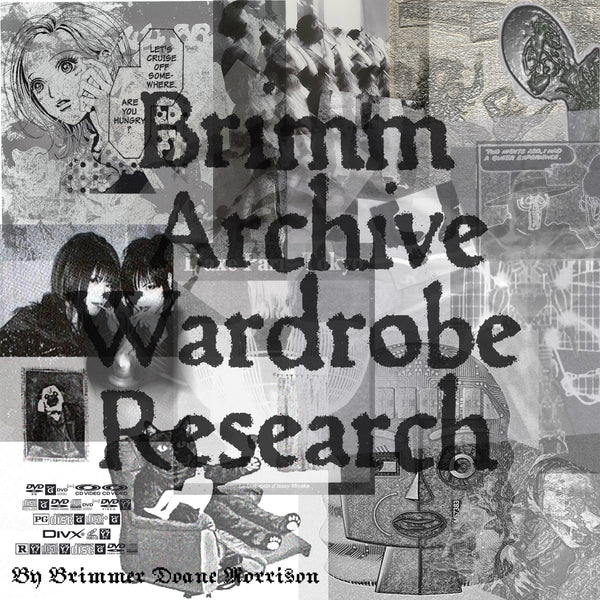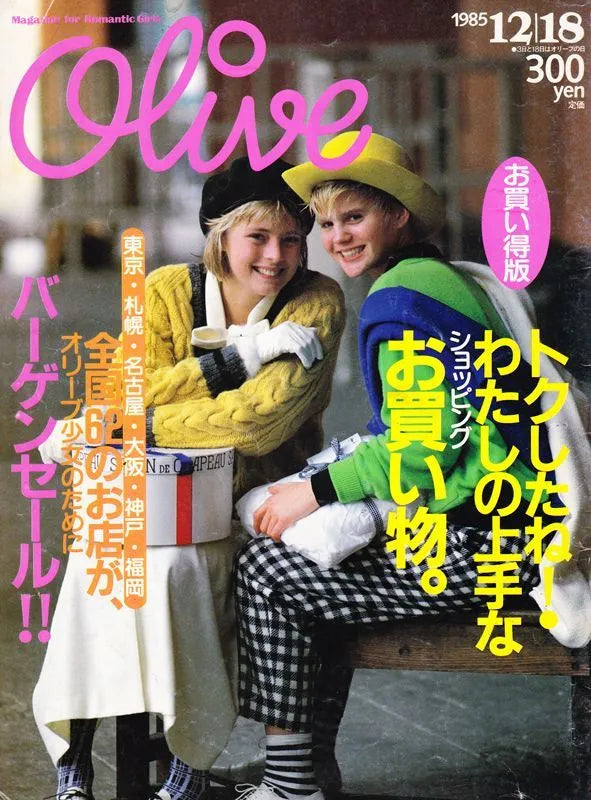For the young creatives in Japan in the 1980’s there were two magazines that directly influenced the styling and fashion culture, CUTiE and Olive.
Olive Magazine
Olive magazine embodied the French schoolgirl aesthetic. The “olive girl” watched French films, had picnics with her friends and idealized pre-World War Two boarding school interests and pastimes. Covers of the magazine would have phrases like:
“Olive girls try to look like the Lyceenne.”[1]

Olive magazine was the first to characterize kawaii style and aesthetic. Both ‘girly’ and ‘boyish’ styles were promoted that reflected French and English street styles. The magazine focused on

The Olive Girl was portrayed wearing clothes lines from popular brands Pink House, 1973 and Milk, 1970. Milk and the brands that signed to Pink House were the first conceptions of the Lolita style with elements of frills, chiffon, lace, and ribbons that reflected a shojo, girlish, innocent image.[2] The slogan for the magazine was “Magazine for City Girls,” a spin on the men’s fashion magazine Popeye, which specialized in an Ivy style. In 1983, the slogan was changed to “Magazine for Romantic Girls.”[3] In this change, the French Schoolgirl (lycéenne) was what girls were supposed to idealize.
Romanticizing girlhood and maidenhood spoke subjectively about what it meant to be a girl and the values that being a ‘girl’ were. The readers wanted to be the hero in their own fairy tale-schoolgirl-kawaii fantasy. In this way, the popularity of this magazine furthered the culture of kawaii by associating these traits, temporal attitudes, aesthetics, emotions, and style to kawaii fashion. As important Olive magazine was to the Lolita movement and kawaii culture, it was not until CUTiE magazine used kawaii to describe Japanese fashion, rather than just conceptually.

CUTiE Magazine
CUTiE magazine was an explosion of content for the purpose of documenting youth culture and defining kawaii style. CUTiE was a mix of street style photography, fashion and beauty advertisements, music, discussion topics and most importantly, implemented shojo manga in the middle of the magazine. The manga drawn for the magazine had high school girls involved in new wave, punk, and club subcultures.[4] The fashion in the magazine was for independent women.
Furthermore, Godoy points out the tipping point for the success of CUTiE was the stylist Sonya Park. Sonya Park saw Comme des Garcons in An An Magazine when she was 13 and saw how much it changed the culture surrounding fashion and clothes. She wanted to document youth fashion culture and in 1987 landed a stylist job for CUTiE.[5] With her prowess, CUTiE continued to define kawaii style into the post-modern era.
With the inclusion of shojo manga in the publication, it embellished upon maidenhood and girlish style that is not meant for the consumption or gaze of men. It further separated the shojo from its original intentions, more than Olive Magazine. Moving away from the karasu zoku (crow tribe) and an-non zoku (tribe based on An-An and Non-no magazines), CUTiE helped solidify the role of fashion as religion in Japan. CUTiE circulated 600,000 magazines per issue at its peak between 1995 and 1999.[6]




Fashion as Religion in Japan
The Shojo Revolution through material expression
Spending on clothing in 1988 was 376.6 billion yen, by 1990, that rose to 826.5 billion yen.[7] Although there are other influences, most of which I have stated in this essay, CUTiE essentially created kawaii fashion culture as we know it today. This presence was internationally recognized when Shoichi Aoki photographed Harajuku Street style in FRUiTS magazine, 1997. With FRUiTS magazine, Japanese street style became an international sensation that accurately documented grass roots Harajuku fashion.
By the mid 1990’s, Lolita fashion culture started to dominate Japanese fashion, notably Gothic Lolita. However subversive and individually creative the fashion was in FRUiTS, or how perfectly girly CUTiE magazine was, they still did not reach a full-on rejection of gender norms, separation from the hetero-reproductive system or character creation that would allow for one to do so. Although the popularity of these magazines was at the same time as the Lolita and Designer Character brand movement, the mid to late 1990’s is when forms of Lolita, specifically Gothic Lolita, exuded the ideologies of Rei Kawakubo and Comme des Garcons, one of the original Designer Character brands, along with the complete subversion of the shojo.
[1] “The Magazine ‘Olive’ Made Japanese Girls Aware of The Rare Value of Girlhood and Maidenhood : The ‘Kawaii 2.0’ Theory Vol.6,” Japanese kawaii idol music culture news | Tokyo Girls Update, accessed February 14, 2022, http://tokyogirlsupdate.com/kawaii-2-0-theory-vol-6-20160694637.html.
[2] Kawamura, Fashioning Japanese Subcultures. Pg. 67
[3] “The Magazine ‘Olive’ Made Japanese Girls Aware of The Rare Value of Girlhood and Maidenhood.”
[4] Jane Mai and An Nguygen, So Pretty, Very Rotten (Koyoma Press, 2017).
[5] Godoy, Style Deficit Disorder: Harajuku Street Fashion - Tokyo. Pg. 130
[6] Bartal, “From Cute to Rei Kawakubo.” Pg. 92
[7] Bartal. Pg. 89

